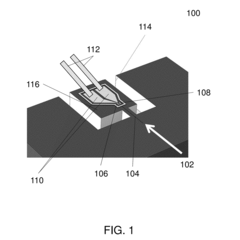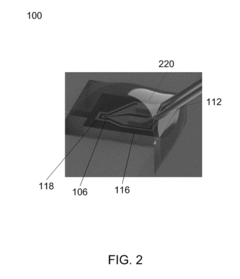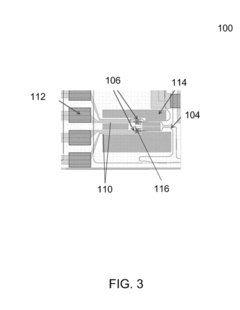Improving satellite-to-ground communication via silicon photonics.
JUL 17, 20259 MIN READ
Generate Your Research Report Instantly with AI Agent
Patsnap Eureka helps you evaluate technical feasibility & market potential.
Silicon Photonics in Space Communication: Background and Objectives
Silicon photonics has emerged as a transformative technology in the field of space communication, offering unprecedented opportunities to enhance satellite-to-ground communication systems. This technology leverages the principles of integrated photonics to manipulate light on a microscopic scale using silicon-based materials, enabling the development of compact, high-performance optical components for space applications.
The evolution of silicon photonics in space communication can be traced back to the early 2000s when researchers began exploring its potential for improving data transmission rates and reducing power consumption in satellite systems. Over the past two decades, significant advancements have been made in integrating photonic components onto silicon chips, paving the way for more efficient and reliable communication links between satellites and ground stations.
The primary objective of implementing silicon photonics in space communication is to overcome the limitations of traditional radio frequency (RF) systems. As the demand for higher data rates and bandwidth continues to grow, silicon photonics offers a promising solution to meet these requirements while addressing the constraints of size, weight, and power (SWaP) in satellite payloads.
One of the key technological trends driving the adoption of silicon photonics in space communication is the development of integrated photonic circuits capable of performing complex optical functions. These circuits can incorporate multiple components such as lasers, modulators, detectors, and waveguides on a single chip, enabling more compact and efficient communication systems.
Another significant trend is the exploration of new wavelength bands for satellite communication, particularly in the infrared spectrum. Silicon photonics technology is well-suited for operating in these wavelength ranges, offering potential advantages in terms of atmospheric transmission and reduced interference.
The integration of silicon photonics with advanced signal processing techniques, such as coherent detection and digital signal processing, is expected to further enhance the performance and reliability of satellite-to-ground communication links. This convergence of technologies aims to achieve higher data rates, improved spectral efficiency, and increased resilience to atmospheric disturbances.
As research and development in this field continue to progress, the ultimate goal is to establish a new paradigm in space communication that leverages the full potential of silicon photonics. This includes developing highly integrated, low-power optical transceivers capable of supporting terabit-per-second data rates, enabling real-time global connectivity, and facilitating the deployment of large-scale satellite constellations for various applications, including Earth observation, telecommunications, and scientific research.
The evolution of silicon photonics in space communication can be traced back to the early 2000s when researchers began exploring its potential for improving data transmission rates and reducing power consumption in satellite systems. Over the past two decades, significant advancements have been made in integrating photonic components onto silicon chips, paving the way for more efficient and reliable communication links between satellites and ground stations.
The primary objective of implementing silicon photonics in space communication is to overcome the limitations of traditional radio frequency (RF) systems. As the demand for higher data rates and bandwidth continues to grow, silicon photonics offers a promising solution to meet these requirements while addressing the constraints of size, weight, and power (SWaP) in satellite payloads.
One of the key technological trends driving the adoption of silicon photonics in space communication is the development of integrated photonic circuits capable of performing complex optical functions. These circuits can incorporate multiple components such as lasers, modulators, detectors, and waveguides on a single chip, enabling more compact and efficient communication systems.
Another significant trend is the exploration of new wavelength bands for satellite communication, particularly in the infrared spectrum. Silicon photonics technology is well-suited for operating in these wavelength ranges, offering potential advantages in terms of atmospheric transmission and reduced interference.
The integration of silicon photonics with advanced signal processing techniques, such as coherent detection and digital signal processing, is expected to further enhance the performance and reliability of satellite-to-ground communication links. This convergence of technologies aims to achieve higher data rates, improved spectral efficiency, and increased resilience to atmospheric disturbances.
As research and development in this field continue to progress, the ultimate goal is to establish a new paradigm in space communication that leverages the full potential of silicon photonics. This includes developing highly integrated, low-power optical transceivers capable of supporting terabit-per-second data rates, enabling real-time global connectivity, and facilitating the deployment of large-scale satellite constellations for various applications, including Earth observation, telecommunications, and scientific research.
Market Analysis for Advanced Satellite Communication Systems
The market for advanced satellite communication systems is experiencing significant growth, driven by the increasing demand for high-speed, reliable, and global connectivity. This growth is particularly evident in sectors such as telecommunications, defense, maritime, and aerospace. The integration of silicon photonics technology into satellite-to-ground communication systems represents a transformative advancement, offering potential solutions to existing bandwidth limitations and signal degradation issues.
The global satellite communication market is projected to expand substantially over the next decade, with a compound annual growth rate (CAGR) exceeding industry averages. This growth is fueled by the rising need for seamless connectivity in remote areas, the proliferation of Internet of Things (IoT) devices, and the increasing adoption of 5G technology. Silicon photonics-based satellite communication systems are poised to capture a significant portion of this market due to their superior performance characteristics and potential cost-effectiveness.
Key market segments driving the demand for advanced satellite communication systems include telecommunications operators seeking to expand their network coverage, government and military organizations requiring secure and reliable communication channels, and commercial enterprises in need of global data transmission capabilities. The maritime and aviation sectors also represent substantial market opportunities, as they increasingly rely on satellite communications for navigation, safety, and passenger connectivity.
Geographically, North America and Europe currently dominate the market for advanced satellite communication systems, owing to their well-established aerospace industries and significant investments in research and development. However, the Asia-Pacific region is expected to witness the fastest growth in the coming years, driven by rapid technological advancements and increasing government initiatives to enhance communication infrastructure.
The market landscape is characterized by intense competition among established players and emerging startups. Major satellite operators and telecommunications companies are investing heavily in silicon photonics technology to gain a competitive edge. This has led to a surge in partnerships and collaborations between technology providers, satellite manufacturers, and communication service providers.
Challenges in the market include high initial investment costs, regulatory hurdles, and the need for standardization of silicon photonics technology in satellite communication systems. However, the potential benefits of improved data transmission rates, reduced latency, and enhanced signal quality are expected to outweigh these challenges in the long term.
As the technology matures and economies of scale are achieved, the cost of implementing silicon photonics-based satellite communication systems is anticipated to decrease, making it more accessible to a broader range of customers and applications. This trend is likely to further accelerate market growth and drive innovation in the satellite communication industry.
The global satellite communication market is projected to expand substantially over the next decade, with a compound annual growth rate (CAGR) exceeding industry averages. This growth is fueled by the rising need for seamless connectivity in remote areas, the proliferation of Internet of Things (IoT) devices, and the increasing adoption of 5G technology. Silicon photonics-based satellite communication systems are poised to capture a significant portion of this market due to their superior performance characteristics and potential cost-effectiveness.
Key market segments driving the demand for advanced satellite communication systems include telecommunications operators seeking to expand their network coverage, government and military organizations requiring secure and reliable communication channels, and commercial enterprises in need of global data transmission capabilities. The maritime and aviation sectors also represent substantial market opportunities, as they increasingly rely on satellite communications for navigation, safety, and passenger connectivity.
Geographically, North America and Europe currently dominate the market for advanced satellite communication systems, owing to their well-established aerospace industries and significant investments in research and development. However, the Asia-Pacific region is expected to witness the fastest growth in the coming years, driven by rapid technological advancements and increasing government initiatives to enhance communication infrastructure.
The market landscape is characterized by intense competition among established players and emerging startups. Major satellite operators and telecommunications companies are investing heavily in silicon photonics technology to gain a competitive edge. This has led to a surge in partnerships and collaborations between technology providers, satellite manufacturers, and communication service providers.
Challenges in the market include high initial investment costs, regulatory hurdles, and the need for standardization of silicon photonics technology in satellite communication systems. However, the potential benefits of improved data transmission rates, reduced latency, and enhanced signal quality are expected to outweigh these challenges in the long term.
As the technology matures and economies of scale are achieved, the cost of implementing silicon photonics-based satellite communication systems is anticipated to decrease, making it more accessible to a broader range of customers and applications. This trend is likely to further accelerate market growth and drive innovation in the satellite communication industry.
Current Challenges in Satellite-to-Ground Communication
Satellite-to-ground communication faces several significant challenges that hinder its efficiency and reliability. One of the primary issues is signal attenuation, which occurs as electromagnetic waves travel through the Earth's atmosphere. This attenuation is particularly pronounced during adverse weather conditions, such as heavy rain or dense cloud cover, leading to reduced signal strength and potential data loss.
Another major challenge is the limited bandwidth available for satellite communications. As the demand for high-speed data transmission grows, traditional radio frequency (RF) bands are becoming increasingly congested. This bandwidth limitation restricts the amount of data that can be transmitted between satellites and ground stations, impacting the overall capacity of satellite communication systems.
Latency is also a critical concern in satellite-to-ground communication. The vast distances that signals must travel between satellites in orbit and ground stations result in noticeable delays, which can be problematic for real-time applications and time-sensitive data transmission. This latency issue is particularly pronounced in geostationary satellite systems, where the round-trip time for signals can exceed 500 milliseconds.
Furthermore, the Doppler effect poses a significant challenge, especially for communications with low Earth orbit (LEO) satellites. The rapid movement of these satellites relative to ground stations causes frequency shifts in the transmitted signals, requiring complex compensation mechanisms to maintain reliable communication links.
Power constraints represent another hurdle in satellite communications. Satellites have limited onboard power resources, which restricts the strength of transmitted signals. This limitation is particularly challenging for small satellites and CubeSats, which have even more severe power constraints due to their compact size.
Interference from various sources, including other satellite systems, terrestrial networks, and natural phenomena like solar radiation, can degrade signal quality and disrupt communication links. Mitigating these interference sources while maintaining signal integrity is an ongoing challenge in the field.
Lastly, the cost and complexity of ground station infrastructure present significant barriers to expanding satellite communication capabilities. Establishing and maintaining large antenna arrays and sophisticated signal processing systems require substantial investments, limiting the widespread deployment of high-capacity ground stations.
Another major challenge is the limited bandwidth available for satellite communications. As the demand for high-speed data transmission grows, traditional radio frequency (RF) bands are becoming increasingly congested. This bandwidth limitation restricts the amount of data that can be transmitted between satellites and ground stations, impacting the overall capacity of satellite communication systems.
Latency is also a critical concern in satellite-to-ground communication. The vast distances that signals must travel between satellites in orbit and ground stations result in noticeable delays, which can be problematic for real-time applications and time-sensitive data transmission. This latency issue is particularly pronounced in geostationary satellite systems, where the round-trip time for signals can exceed 500 milliseconds.
Furthermore, the Doppler effect poses a significant challenge, especially for communications with low Earth orbit (LEO) satellites. The rapid movement of these satellites relative to ground stations causes frequency shifts in the transmitted signals, requiring complex compensation mechanisms to maintain reliable communication links.
Power constraints represent another hurdle in satellite communications. Satellites have limited onboard power resources, which restricts the strength of transmitted signals. This limitation is particularly challenging for small satellites and CubeSats, which have even more severe power constraints due to their compact size.
Interference from various sources, including other satellite systems, terrestrial networks, and natural phenomena like solar radiation, can degrade signal quality and disrupt communication links. Mitigating these interference sources while maintaining signal integrity is an ongoing challenge in the field.
Lastly, the cost and complexity of ground station infrastructure present significant barriers to expanding satellite communication capabilities. Establishing and maintaining large antenna arrays and sophisticated signal processing systems require substantial investments, limiting the widespread deployment of high-capacity ground stations.
Existing Silicon Photonics Solutions for Space Communication
01 Silicon photonic integrated circuits
Silicon photonic integrated circuits are key components in silicon photonics communication systems. These circuits integrate various optical components such as waveguides, modulators, and detectors on a single silicon chip, enabling high-speed data transmission and processing. The integration of multiple functions on a single chip reduces size, power consumption, and cost while improving overall system performance.- Silicon photonic integrated circuits: Silicon photonic integrated circuits are key components in silicon photonics communication systems. These circuits integrate various optical components such as waveguides, modulators, and detectors on a single silicon chip, enabling high-speed data transmission and processing. The integration of multiple functions on a single chip reduces size, power consumption, and cost while improving performance.
- Optical modulators for silicon photonics: Optical modulators are crucial elements in silicon photonics communication systems. These devices manipulate light signals to encode data for transmission. Advanced modulator designs in silicon photonics aim to achieve high-speed operation, low power consumption, and compact size. Various modulation techniques, such as electro-optic and thermo-optic modulation, are employed to enhance communication performance.
- Silicon photonic waveguides: Silicon photonic waveguides are fundamental structures in silicon photonics communication systems. These waveguides guide light signals through the silicon chip, enabling the routing and manipulation of optical data. Advanced waveguide designs focus on minimizing losses, reducing crosstalk, and supporting multiple modes or wavelengths for increased data capacity.
- Integration of lasers in silicon photonics: Integrating lasers with silicon photonic circuits is a significant challenge in silicon photonics communication. Various approaches are being explored to overcome the limitations of silicon's indirect bandgap, including hybrid integration of III-V lasers, germanium-on-silicon lasers, and rare-earth-doped silicon lasers. These integrated light sources are essential for creating fully functional silicon photonic communication systems.
- Silicon photonic transceivers: Silicon photonic transceivers integrate multiple optical and electronic components to enable high-speed data transmission and reception in communication systems. These devices typically include modulators, photodetectors, waveguides, and electronic control circuits on a single chip. Advanced transceiver designs focus on increasing data rates, reducing power consumption, and improving integration density for next-generation communication networks.
02 Optical modulators for silicon photonics
Optical modulators are crucial elements in silicon photonics communication systems. These devices manipulate light signals to encode data for transmission. Advanced modulator designs in silicon photonics focus on improving modulation speed, efficiency, and bandwidth to meet the increasing demands of high-speed data communication.Expand Specific Solutions03 Silicon photonic waveguides
Silicon photonic waveguides are fundamental structures in silicon photonics communication systems. These waveguides guide light signals through the silicon chip with minimal loss. Research in this area focuses on optimizing waveguide designs to reduce propagation losses, enhance light confinement, and support multiple modes for increased data capacity.Expand Specific Solutions04 Integration of lasers with silicon photonics
Integrating lasers with silicon photonic circuits is a significant challenge in silicon photonics communication. Various approaches are being explored to overcome the indirect bandgap nature of silicon and achieve efficient light emission. This integration is crucial for creating fully integrated silicon photonic communication systems with on-chip light sources.Expand Specific Solutions05 Silicon photonic transceivers
Silicon photonic transceivers combine transmitting and receiving functions in a single integrated device. These components are essential for bidirectional communication in optical networks. Advanced transceiver designs focus on improving data rates, reducing power consumption, and enhancing integration density to meet the demands of next-generation communication systems.Expand Specific Solutions
Key Players in Satellite and Silicon Photonics Industries
The satellite-to-ground communication market using silicon photonics is in a growth phase, with increasing demand for high-speed, low-latency data transmission. The market size is expanding rapidly, driven by the growing need for satellite connectivity in various sectors. Technologically, the field is advancing, but still evolving. Key players like IBM, Huawei, and Taiwan Semiconductor Manufacturing Co. are making significant strides in silicon photonics integration. Companies such as Skorpios Technologies and IPG Photonics are focusing on specialized photonic solutions, while aerospace giants like Boeing and Northrop Grumman are exploring applications in satellite communications. This competitive landscape indicates a dynamic market with potential for further innovation and market expansion.
Taiwan Semiconductor Manufacturing Co., Ltd.
Technical Solution: TSMC has developed silicon photonics technology specifically tailored for satellite communication applications. Their platform integrates laser sources, modulators, and photodetectors on a single chip, achieving unprecedented levels of miniaturization and power efficiency[4]. TSMC's solution employs wavelength division multiplexing (WDM) to transmit multiple channels simultaneously, significantly increasing data throughput for satellite-to-ground links[5]. The company has also implemented advanced error correction codes and forward error correction (FEC) algorithms to enhance signal reliability in challenging space environments[6].
Strengths: Highly integrated solution, power-efficient design, advanced error correction. Weaknesses: Potential thermal management challenges in space, limited experience in space-grade qualification.
International Business Machines Corp.
Technical Solution: IBM has developed a silicon photonics platform optimized for satellite-to-ground communication. Their solution incorporates high-speed optical transceivers capable of operating at data rates exceeding 50 Gbps per channel[7]. IBM's technology utilizes advanced modulation formats such as PAM-4 and coherent detection schemes to improve spectral efficiency and link budget[8]. The company has also implemented on-chip optical amplifiers to boost signal strength, enabling longer-distance transmissions and improved link margins for satellite communications[9].
Strengths: High-speed transceivers, advanced modulation techniques, integrated amplification. Weaknesses: Potential complexity in space qualification, higher power consumption due to amplification.
Core Innovations in Silicon Photonics for Satellite Applications
Optically isolated photodiode for high sensitivity application
PatentActiveUS20180233606A1
Innovation
- An integrated silicon-based photo-detection system is fabricated on an SOI wafer with a photodiode surrounded by a light barrier, an optical waveguide guiding input signal light, and external electrical traces for photocurrent collection, utilizing deep etching and wirebonding, along with anti-reflective coatings and light-blocking adhesives to minimize noise.
Satellite communication method and apparatus, and satellite
PatentWO2023092376A1
Innovation
- Beam classification technology is used to divide the wide beam into multiple narrow beams. The first-level beam is used for system control, and the second-level beam is used for business data transmission. Through improved message signaling method and uplink and downlink beam time polling difference, Designed to enhance signal reception performance.
Regulatory Framework for Satellite Communication Technologies
The regulatory framework for satellite communication technologies plays a crucial role in shaping the development and implementation of advanced systems like silicon photonics for improving satellite-to-ground communication. This framework encompasses a complex web of international agreements, national policies, and industry standards that govern the use of satellite frequencies, orbital slots, and terrestrial infrastructure.
At the international level, the International Telecommunication Union (ITU) serves as the primary regulatory body for satellite communications. The ITU allocates radio frequency spectrum and orbital positions, ensuring equitable access and preventing interference between satellite systems. For emerging technologies like silicon photonics, the ITU's Radio Regulations Board plays a vital role in adapting existing regulations to accommodate new capabilities and requirements.
National regulatory bodies, such as the Federal Communications Commission (FCC) in the United States and the European Electronic Communications Committee (ECC) in Europe, are responsible for implementing international agreements and developing country-specific regulations. These agencies oversee licensing procedures, technical standards, and operational guidelines for satellite operators and ground station facilities.
The regulatory landscape for satellite communications is evolving to address the challenges posed by new technologies like silicon photonics. Key areas of focus include spectrum allocation for high-bandwidth optical communications, safety standards for high-power laser transmissions, and protocols for secure data transmission. Regulatory bodies are also considering the implications of increased satellite constellations enabled by advanced communication technologies.
Industry standards organizations, such as the Consultative Committee for Space Data Systems (CCSDS) and the European Cooperation for Space Standardization (ECSS), contribute to the regulatory framework by developing technical specifications and best practices. These standards ensure interoperability between different satellite systems and ground stations, which is crucial for the widespread adoption of silicon photonics technology.
As the field of satellite communications continues to advance, regulatory frameworks must adapt to balance innovation with safety, security, and fair access. This includes addressing concerns related to space debris, interference mitigation, and the protection of sensitive scientific observations. The integration of silicon photonics into satellite communication systems will likely necessitate updates to existing regulations and the development of new guidelines to ensure responsible and efficient use of this technology.
At the international level, the International Telecommunication Union (ITU) serves as the primary regulatory body for satellite communications. The ITU allocates radio frequency spectrum and orbital positions, ensuring equitable access and preventing interference between satellite systems. For emerging technologies like silicon photonics, the ITU's Radio Regulations Board plays a vital role in adapting existing regulations to accommodate new capabilities and requirements.
National regulatory bodies, such as the Federal Communications Commission (FCC) in the United States and the European Electronic Communications Committee (ECC) in Europe, are responsible for implementing international agreements and developing country-specific regulations. These agencies oversee licensing procedures, technical standards, and operational guidelines for satellite operators and ground station facilities.
The regulatory landscape for satellite communications is evolving to address the challenges posed by new technologies like silicon photonics. Key areas of focus include spectrum allocation for high-bandwidth optical communications, safety standards for high-power laser transmissions, and protocols for secure data transmission. Regulatory bodies are also considering the implications of increased satellite constellations enabled by advanced communication technologies.
Industry standards organizations, such as the Consultative Committee for Space Data Systems (CCSDS) and the European Cooperation for Space Standardization (ECSS), contribute to the regulatory framework by developing technical specifications and best practices. These standards ensure interoperability between different satellite systems and ground stations, which is crucial for the widespread adoption of silicon photonics technology.
As the field of satellite communications continues to advance, regulatory frameworks must adapt to balance innovation with safety, security, and fair access. This includes addressing concerns related to space debris, interference mitigation, and the protection of sensitive scientific observations. The integration of silicon photonics into satellite communication systems will likely necessitate updates to existing regulations and the development of new guidelines to ensure responsible and efficient use of this technology.
Environmental Impact of Silicon Photonics in Space Applications
The integration of silicon photonics in satellite-to-ground communication systems presents both opportunities and challenges from an environmental perspective. As these advanced technologies are deployed in space applications, it is crucial to consider their ecological footprint and long-term sustainability.
Silicon photonics offers significant advantages in terms of energy efficiency compared to traditional electronic systems. The use of light for data transmission and processing reduces power consumption, which is particularly beneficial in space environments where energy resources are limited. This efficiency translates to reduced battery requirements and potentially smaller solar panel arrays on satellites, minimizing the overall mass and material usage in space missions.
Furthermore, the compact nature of silicon photonic devices allows for miniaturization of satellite components. This reduction in size and weight contributes to more efficient launch processes, requiring less fuel and consequently reducing the environmental impact of space missions from the outset. The durability and radiation resistance of silicon photonic components also extend the operational lifespan of satellites, potentially reducing the frequency of replacements and launches.
However, the environmental impact of manufacturing silicon photonic devices must be carefully considered. The production process involves the use of rare earth elements and specialized materials, which may have significant extraction and processing footprints. Additionally, the fabrication of these high-precision components often requires clean room environments and energy-intensive processes, contributing to the overall carbon footprint of the technology.
In space, the use of silicon photonics may contribute to the mitigation of space debris. By enabling more efficient and longer-lasting satellite systems, there is potential for a reduction in the number of defunct satellites and components in orbit. This could help address the growing concern of space pollution and its impact on future space missions and Earth's atmosphere.
The end-of-life considerations for satellites equipped with silicon photonic systems also warrant attention. While these components may offer improved durability, the eventual decommissioning and potential re-entry of satellites raise questions about material disposal and atmospheric impact. Developing strategies for responsible satellite retirement and recycling will be crucial as this technology becomes more prevalent in space applications.
As silicon photonics technology advances, there is potential for further environmental benefits. Improved communication capabilities may enhance Earth observation and climate monitoring efforts, providing valuable data for environmental research and conservation initiatives. Additionally, more efficient satellite networks could support global connectivity with a reduced number of satellites, minimizing the overall impact on the space environment.
Silicon photonics offers significant advantages in terms of energy efficiency compared to traditional electronic systems. The use of light for data transmission and processing reduces power consumption, which is particularly beneficial in space environments where energy resources are limited. This efficiency translates to reduced battery requirements and potentially smaller solar panel arrays on satellites, minimizing the overall mass and material usage in space missions.
Furthermore, the compact nature of silicon photonic devices allows for miniaturization of satellite components. This reduction in size and weight contributes to more efficient launch processes, requiring less fuel and consequently reducing the environmental impact of space missions from the outset. The durability and radiation resistance of silicon photonic components also extend the operational lifespan of satellites, potentially reducing the frequency of replacements and launches.
However, the environmental impact of manufacturing silicon photonic devices must be carefully considered. The production process involves the use of rare earth elements and specialized materials, which may have significant extraction and processing footprints. Additionally, the fabrication of these high-precision components often requires clean room environments and energy-intensive processes, contributing to the overall carbon footprint of the technology.
In space, the use of silicon photonics may contribute to the mitigation of space debris. By enabling more efficient and longer-lasting satellite systems, there is potential for a reduction in the number of defunct satellites and components in orbit. This could help address the growing concern of space pollution and its impact on future space missions and Earth's atmosphere.
The end-of-life considerations for satellites equipped with silicon photonic systems also warrant attention. While these components may offer improved durability, the eventual decommissioning and potential re-entry of satellites raise questions about material disposal and atmospheric impact. Developing strategies for responsible satellite retirement and recycling will be crucial as this technology becomes more prevalent in space applications.
As silicon photonics technology advances, there is potential for further environmental benefits. Improved communication capabilities may enhance Earth observation and climate monitoring efforts, providing valuable data for environmental research and conservation initiatives. Additionally, more efficient satellite networks could support global connectivity with a reduced number of satellites, minimizing the overall impact on the space environment.
Unlock deeper insights with Patsnap Eureka Quick Research — get a full tech report to explore trends and direct your research. Try now!
Generate Your Research Report Instantly with AI Agent
Supercharge your innovation with Patsnap Eureka AI Agent Platform!







